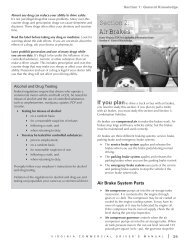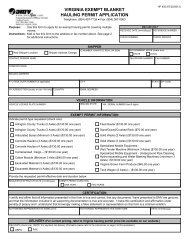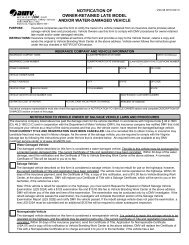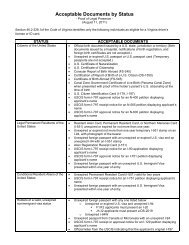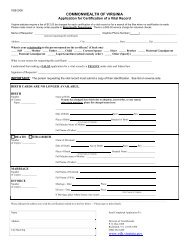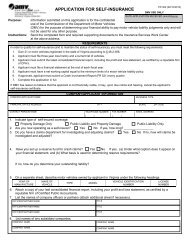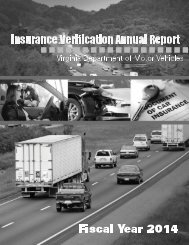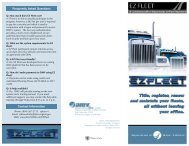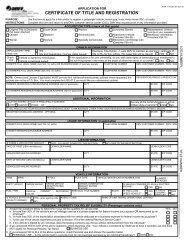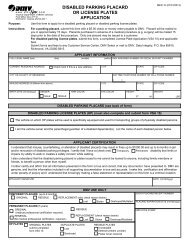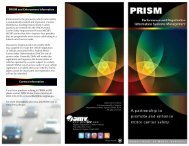Section 3: Safe Driving - Virginia Department of Motor Vehicles
Section 3: Safe Driving - Virginia Department of Motor Vehicles
Section 3: Safe Driving - Virginia Department of Motor Vehicles
Create successful ePaper yourself
Turn your PDF publications into a flip-book with our unique Google optimized e-Paper software.
<strong>Section</strong> 3: <strong>Safe</strong> <strong>Driving</strong>can be a major obstacle for a motorcyclist. Expect themotorcycle to make sudden moves within the lane.Never drive beside a motorcycle in the same lane.Yield to motorcycles. The small size <strong>of</strong> a motorcyclecan cause you to misjudge the motorcycle’s speed anddistance. Before pulling out into traffic, check twice formotorcycles and use extra caution before you pull outin front <strong>of</strong> one.Light Rail: There is a light rail train system in Norfolk calledThe Tide. Light rail trains share the road with motor vehiclesand bicyclists, and they intersect with motor vehicle traffic at27 locations along the 7.4 mile route. Stay safe when drivingaround The Tide by obeying the tips below.Pay attention to changing traffic patterns and alwaysfollow the roadway.Never drive around lowered crossing gates.Always look both ways before turning across train tracks.Expect trains on any track at any time.Always obey signs and traffic signals.Never stop, pass or shift on train tracks.Don’t cross train tracks unless you have enough room tocross without stopping and can clear the tracks to a safedistance.For more info about light rail safety, visit www.gohrt.com or call(757) 222-6100.Low Speed <strong>Vehicles</strong>: These electrically powered four-wheelvehicles have a maximum speed ranging from 21 to 25 MPH.Low speed vehicles may be operated on public roads withspeed limits <strong>of</strong> 35 MPH or less by licensed drivers or learner’spermit holders accompanied by a licensed driver. Low speedvehicles must comply with all federal safety standards and mustmeet <strong>Virginia</strong>’s requirements for passenger vehicle registrationand insurance coverage. Golf carts are not classified as lowspeed vehicles.Trucks, Tractor-Trailers, Buses and RVs: Trucks, tractortrailers,buses and recreational vehicles (RVs) – includingmotor homes, campers and travel trailers – are longer, higherand wider than other vehicles. They accelerate slowly andrequire greater stopping and turning distances. Plus, there aredanger areas around these vehicles where crashes are morelikely to occur. These areas are called No-Zones. No-Zones onthe side, front and rear also include blind spots where your cardisappears from the driver’s view. Learning the No-Zones cansave your life.Side No-Zones: Trucks, tractor-trailers, buses and RVshave big No-Zones on both sides that are dangerousbecause these vehicles must make wide turns. TheseNo-Zones or blind spots are much larger than your car’sblind spots. If you can’t see the driver’s face in his sideview mirror, then he can’t see you.Rear No-Zone: Trucks, tractor-trailers, buses and RVshave huge No-Zones directly behind them. The drivercan’t see yourcar behind hisvehicle and youcan’t see what’shappening intraffic ahead <strong>of</strong>his vehicle. Ifthe truck, busor RV brakes orstops suddenly,you have noplace to go andcould crash intothe vehicle’srear-end. Alwaysmaintain asafe followingdistance.Front No-Zone:You could get rear-ended by a truck, bus or RV if you cutin front too soon after passing the vehicle or if you cutin front and then suddenly slow down. The truck, busand RV drivers would be forced to slam on their brakes.These vehicles need nearly twice the time and room tostop as cars. A truck and its trailer may be as long as 65feet and it may take you more than half a mile <strong>of</strong> clearroad to pass. When passing, look for the entire front <strong>of</strong>the truck in your rearview mirror before pulling in front.And then, maintain your speed.Wide Turns: Trucks, buses and RVs sometimes need toswing wide to the left or right to safely make a turn. Theycan’t see the cars directly behind or beside them. In fact,their blind spots may stretch up to 20 feet in front <strong>of</strong>the cab and approximately 200 feet behind the vehicle.Never try to squeeze between a truck, bus or RV and thecurb or another vehicle.Light to Medium Trailers: These trailers are attached to midsizedcars and trucks with safety chains and a trailer hitch.Large side mirrors are generally needed to increase visibility.Towing a trailer places additional stress on the vehicle; it takesthe vehicle twice as long to pass, stop, accelerate and turn.Remember the No-Zones described under Trucks, Tractor-Trailers and RVs.Before driving a vehicle with a light to medium trailerattached, perform a safety inspection before each trip. Ensure:the pin securing the ball mount to the receiver is intactthe hitch coupler is securedsafety chains are properly attachedthe electrical plug is properly installedbrake lights, turn signals, and license plate lights arefunctioning properly.Before pulling a trailer on public roads, find a location such asa vacant parking lot to practice and get the feel for how yourvehicle and trailer will handle.20 | V I R G I N I A D R I V E R ’ S M A N U A L



